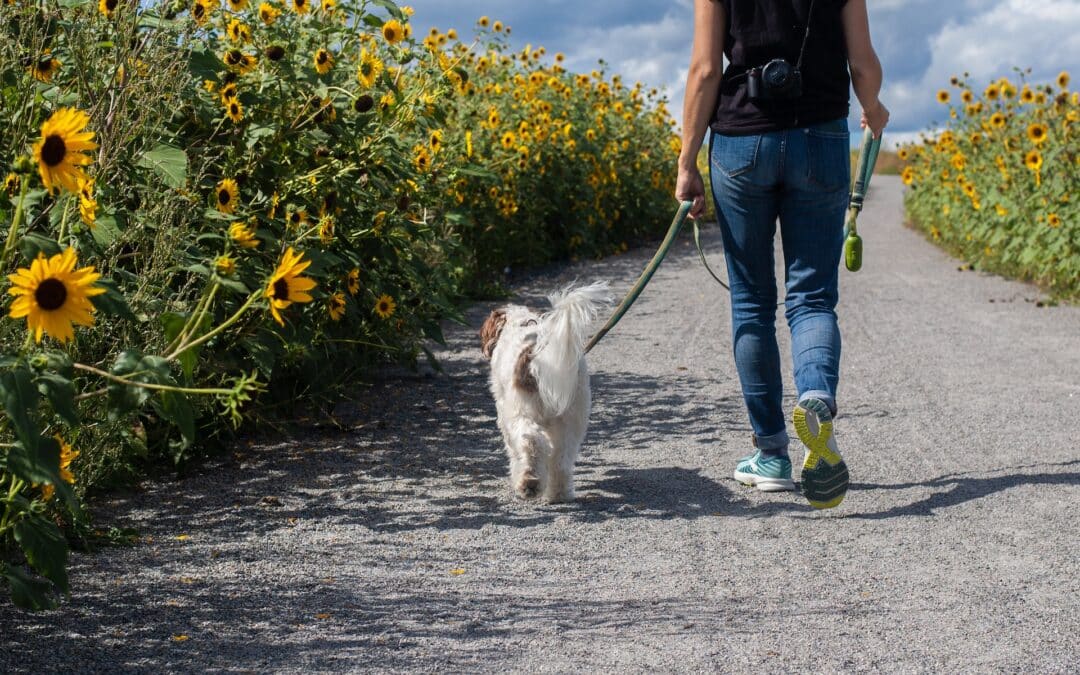Walking your dog is an important part of keeping them happy and healthy. Exercise keeps their bodies fit and provides socialization. But sometimes going for a walk can feel like a drag—quite literally if you have a dog who likes to pull—or if walks tend to make them over-excited or scared.
Dogs are all very different, and walking your dog can be complicated. To make it more pleasant for you both, it’s important to have the right gear. The right leash and collar or harness can go a long way toward protecting your pet as well.
But choosing a collar goes way beyond finding one in your dog’s favorite color. How do you know which collar or harness will make walks more enjoyable? This quick guide goes over the pros and cons of collars and harnesses so you can narrow down your options.
Collars vs. Harnesses—Pros and Cons
Dog Collar Pros:
- They keep ID tags attached to your pup at all times.
- They’re easy to put on and take off.
- There are many styles with different features:
- Flat collars—Great for dogs with bigger heads, because they won’t slip off.
- Over-the-nose—This style is good for leash-training because it reduces pulling.
- Slip collars—Good for dogs whose heads are slightly smaller or the same size as their necks, because it is less likely to slip off.
- Rolled leather collars—Best for long-haired dogs, because the rolled leather is less likely to mat the fur.
Dog Collar Cons:
- Collars can be harmful to your dog’s throat if used incorrectly.
- Pugs and other flat-faced dogs that suffer from brachycephalic airway obstruction syndrome should not wear collars.
- Collars can slip off if they are not fitted well.
Dog Harness Pros:
- Safer for your dog’s throat.
- Better for hiking, because you can lift them by the leash if necessary.
- There are many styles and options for different types of activities:
- Back attach—Best for tie-outs.
- Front attach—Helps to reduce pulling by forcing your dog to turn when they pull forward.
- Backpack style—Great for larger dogs who can carry their own things like poop bags, snacks, and even water on long hikes.
- Back attach with padding—Great for bike rides and other sports.
Dog Harness Cons:
- A poor fitting harness can cause sores and infections in the armpit areas.
- May trigger the “sled dog” effect, where your dog will pull harder and force you to go faster.
It Might Take Time to Adjust to New Gear
If you’re still looking for the perfect collar or harness, it is important to remember that adjusting to change is hard for dogs. Finding a set of equipment that works well for both of you can be complicated. So unless a collar or harness makes you worried about your dog’s safety, give every new selection a trial period of at least two weeks.
Why Two Weeks?
Two weeks is a good amount of time to decide if a collar or harness is right, because:
- It gives your dog time to get used to the new item
- Gives you time to learn how to fit it and use it correctly
- Allows you both the time to learn how the other responds to the new gear
What About Prongs?
We did not include prong collars on our list, because improper use can be harmful and even deadly. Prong collars should only be used under the careful supervision of an experienced dog trainer or veterinarian, and only for short amounts of time.
Exceptional Veterinary Care
When it comes to our dogs, we like both collars and harnesses. A collar is great for holding ID tags, and for short, leashed walks. We also like front-attach harnesses for hikes or long walks around the neighborhood.
But we also know that every dog is different, and as experienced veterinarians, we can give you advice on the type of collars and harnesses that would be best for your dog.
At East Valley Animal Hospital we always encourage you to ask us questions about your pet during their wellness exams—any question at all! From building the best diets to helping you find the perfect collar or harness, we’re here for you and your dog. Contact us today to make an appointment.
Images used under creative commons license – commercial use (8/28/23). Photo by Delphine Beausoleil on Unsplash.

